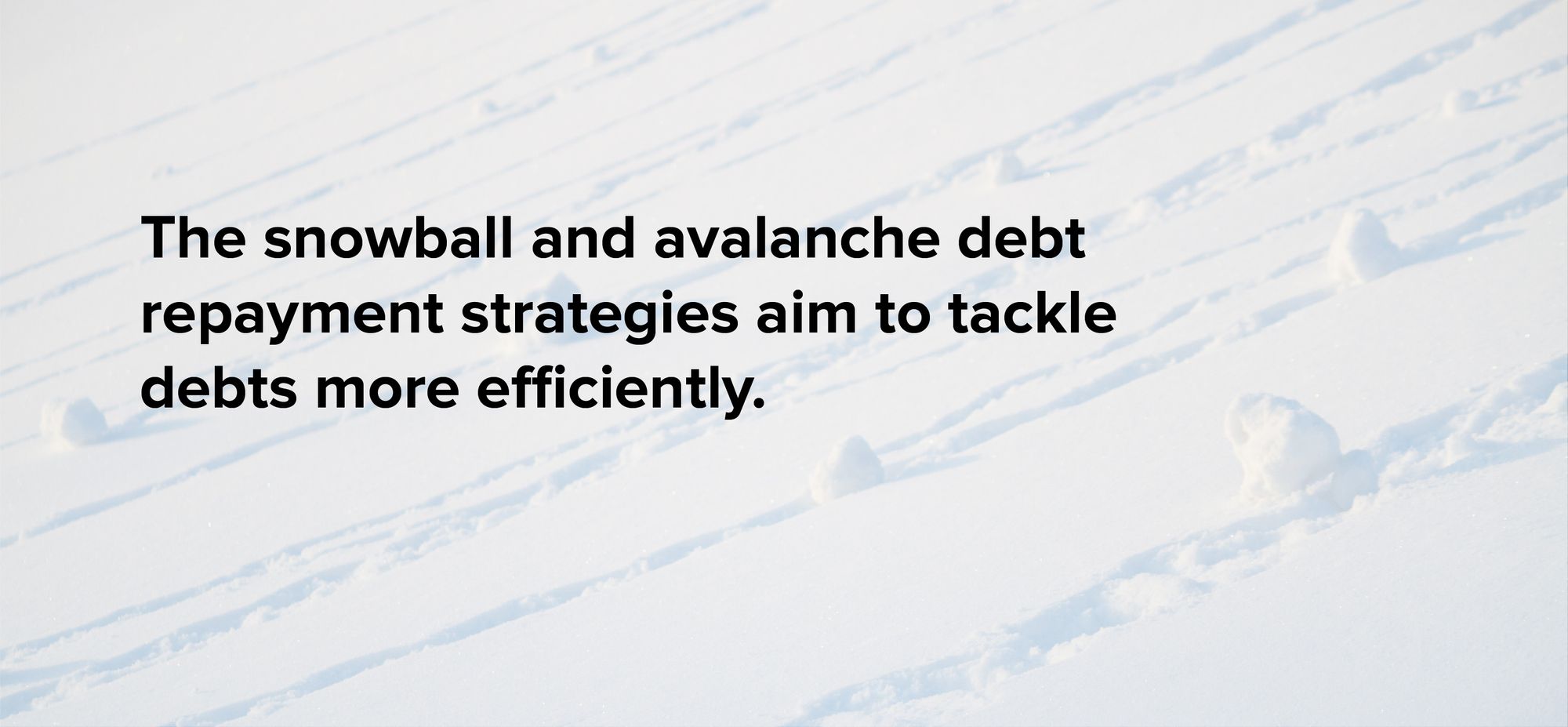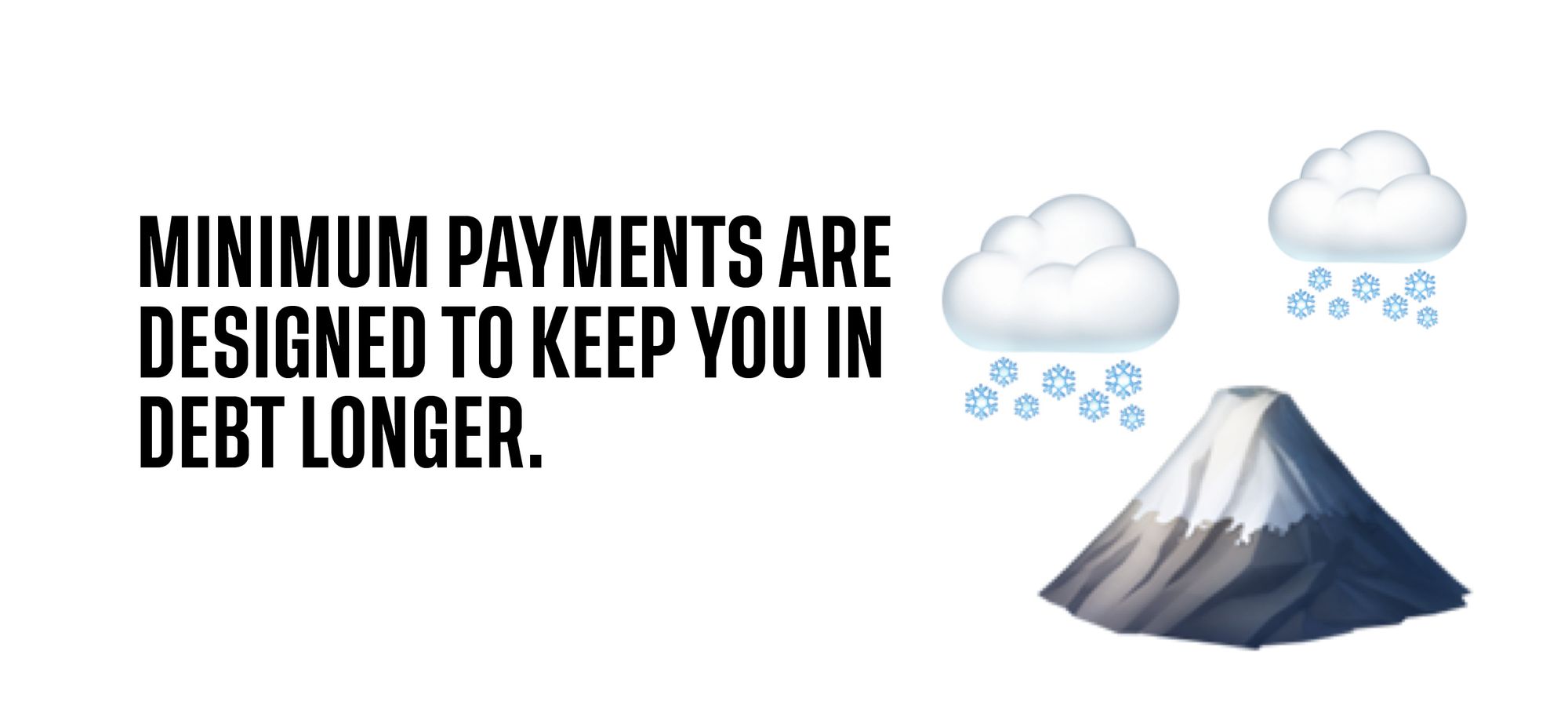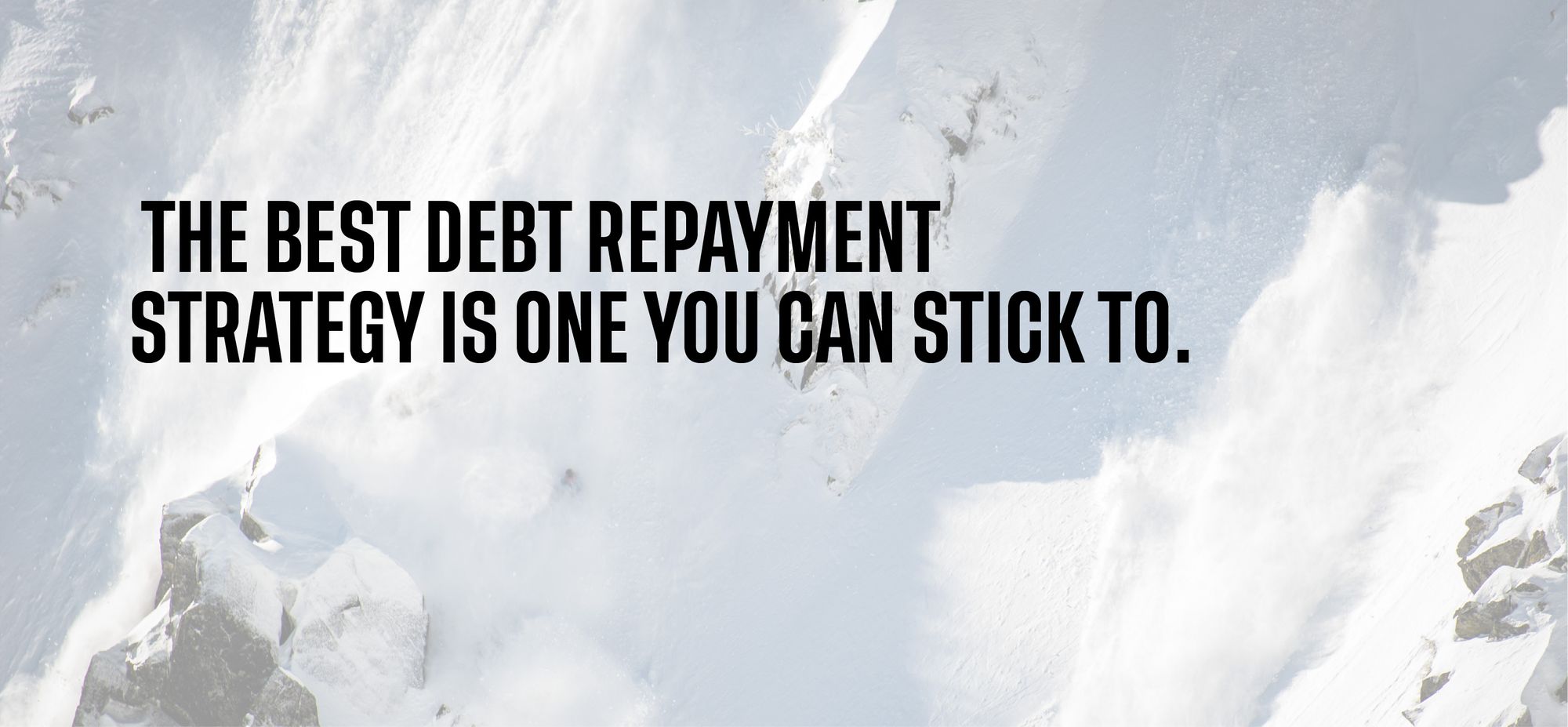Two Strategies For Efficient Debt Repayment
When a snowball becomes an avalanche.
Debt repayment can feel like an unending, especially unique form of torture. You make your minimum payments every month, and yet the number you owe seems to shrink so, so slowly. Will it ever be paid off?
There are two common strategies that some experts say can help you pay down your debt faster. They’re called the snowball and avalanche strategies, and while they sound real cutesy, there’s some real tactical cleverness behind them.
Wanna learn what they are? We’ll tell ya!
Debt Snowball and Debt Avalanche Applications

The first thing to know is that these two strategies only work for folks with multiple debts. Maybe it’s a car loan and a credit card, or a handful of credit cards, or a line of credit and a personal loan. They both offer a strategy for tackling numerous debts more efficiently.
Both methods also require you to make payments in varying amounts. For this reason, they don’t work on debts like mortgages, which typically require a fixed payment on a fixed schedule.
Minimum Payments Suck

The second thing to know is that minimum payments are designed to keep you in debt longer.
What? Really? But don’t lenders want me to pay them back?
Yes, they do—but they want you to pay them back slowly, over a long period. This allows them to assess more interest charges and collect more from you over time. This is why debt can cost you more the longer you hold it.
So if you’re making only minimum payments on your debt, the first thing to do is consider if you could afford to accelerate your payment schedule. Even if you can only afford to up those payments by a few dollars, it could really help.
The interesting thing is both the snowball method and the avalanche method rely on minimum payments to work. In this scenario, the payments work more like maintenance fees while you work through your debt in stages. This is basically the only time making minimum payments on your debt might be reasonable.
What’s the Debt Snowball Method?

The snowball method tackles the mental game of debt repayment.
In this strategy, you make your minimum payments on all of your debt except the smallest debt you hold. On this debt, you chuck any extra cash you have onto those payments.
If you hold three debts, one $1,000 debt, one $700 debt, and one $100 debt, you’d make the minimum payments on the first two, but would make accelerated payments on the $100 debt.
The idea is that this can help enable you to pay off the smaller debts faster, which feels like a huge win. When you pay off your $100 debt, you start paying off your $700 debt at an accelerated rate. Lastly, you tackle your $1,000 debt in the same manner.
The “snowball” name comes from the momentum you build as you tick each debt off your list. According to a recent study from the Harvard Business Review, this repayment method is the best of the bunch, noting “focusing on paying down the account with the smallest balance tends to have the most powerful effect on people’s sense of progress – and therefore their motivation to continue paying down their debts.”If you struggle with the mental commitment required to pay off your debt, this could be a great strategy for you.
The biggest criticism of this method is that by focusing on the debt with the smallest value, you may be letting other higher interest debts drag on, costing you more over time. You should review your interest rates to determine if this concern is relevant to you.
The Avalanche Method
Then there’s the snowball method’s big bro: the avalanche method.
Instead of tackling your smallest debt first, the avalanche method looks at the debt with the highest interest rate. This could be your smallest debt, your biggest debt, or the one smack in the middle; high interest rates can be what traps us in a debt cycle, so focusing on eliminating the debt with the highest interest rate is meant to reduce the cost of your debt over time.
Say we have the same debts: $1,000, $700, and $100. The first and third have the same interest rate, say 12%. But the $700 debt has a 24.99% interest rate.
A minimum payment on a $700 debt could be around $20 depending on your credit score. If you only made the minimum payment on that debt, it would take approximately 16 years and 4 months to pay it off, and you’d pay $1,098 in interest.
Yeah. You’d pay more in interest than the principal balance owing, and by the end, your debt would be old enough to hold a Learner’s Driver’s License in most parts of Canada.
By redirecting any extra funds to tackle that high interest debt first, you’re intending to shorten your repayment period and save money over time. If you have debt that has a high interest rate, the avalanche method could be perfect for you.
The challenge is that it takes real commitment and discipline to stay consistent in your debt payments, which is critical to the success of this strategy.
Which Debt Repayment Strategy Might Be Right For Me?

Your circumstances are totally unique, so only you know which may be the best debt repayment strategy for you. But you can embrace a few helpful ideas that might make your journey to debt freedom a bit easier.
You could also consider debt consolidation. By obtaining a loan at a lower interest rate and using that loan to repay your other higher interest debts, you could save money in interest charges over time. You can read more about that here.
You might also hold the type of debt that doesn’t—strictly speaking—need to be paid down right away, like a student loan or a mortgage. Read more about that here.
And if you need to work on saving money so you have spare cash to pay down your debts more aggressively, consider making the switch to the MogoCard. According to a recent Mogo survey, some MogoCard users reported saving an average of $201 per month just by using the card to control their daily spending (and don’t forget, we plant a tree every time you tap!).2 That extra pocket change could help make a big difference.
Ultimately, the best debt repayment strategy is one you can stick to. Make more than your minimum payments if you can, pick a plan, and stick to it. You can be debt free—just keep at it.
| GET MY FREE MOGOCARD |
This blog is provided for informational purposes only.
*Trademark of Visa International Service Association and used under licence by Peoples Trust Company. Mogo Visa Platinum Prepaid Card is issued by Peoples Trust Company pursuant to licence by Visa Int. and is subject to Terms and Conditions, visit mogo.ca for full details. Your MogoCard balance is not insured by the Canada Deposit Insurance Corporation (CDIC). MogoCard means the Mogo Visa Platinum Prepaid Card.
1-Pre-approval is based on information submitted in your MogoAccount application and/or other information that indicates you could meet our underwriting requirements. Your pre-approval for credit remains subject to our credit approval process which includes but is not limited to income and identity verification and validation of information submitted through the Mogo.ca website. To meet our underwriting requirements further documentation may be requested from you. Minimum income requirements may apply for some products. Approval is not guaranteed and we reserve the right to deny services to you. Final approval is subject to review and verification of income and supporting documents provided.
2-Based on an online survey of active MogoCard users by Mogo Inc. conducted between July 13, 2021 and July 16, 2021, with 1,446 respondents to a combination of multiple choice and fillable text box questions. 91% of respondents agreed that the MogoCard can help them better control their spending. 66.5% of respondents reported that they were spending less on discretionary spending now that they were using the MogoCard, with respondents reporting that they believed to have an average savings of $201 per month (based on 902 respondents who specified an amount and excluding 60 respondents who did not specify any amount).